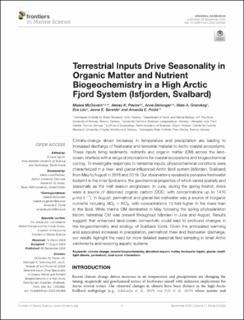| dc.contributor.author | Mcgovern, Maeve | |
| dc.contributor.author | Pavlov, Alexey K. | |
| dc.contributor.author | Deininger, Anne | |
| dc.contributor.author | Granskog, Mats | |
| dc.contributor.author | Leu, Eva Susanne | |
| dc.contributor.author | Søreide, Janne | |
| dc.contributor.author | Poste, Amanda | |
| dc.date.accessioned | 2020-09-17T11:12:54Z | |
| dc.date.available | 2020-09-17T11:12:54Z | |
| dc.date.created | 2020-09-02T11:58:57Z | |
| dc.date.issued | 2020 | |
| dc.identifier.citation | Frontiers in Marine Science. 2020, 7, 542563. | en_US |
| dc.identifier.issn | 2296-7745 | |
| dc.identifier.uri | https://hdl.handle.net/11250/2678247 | |
| dc.description.abstract | Climate-change driven increases in temperature and precipitation are leading to increased discharge of freshwater and terrestrial material to Arctic coastal ecosystems. These inputs bring sediments, nutrients and organic matter (OM) across the land-ocean interface with a range of implications for coastal ecosystems and biogeochemical cycling. To investigate responses to terrestrial inputs, physicochemical conditions were characterized in a river- and glacier-influenced Arctic fjord system (Isfjorden, Svalbard) from May to August in 2018 and 2019. Our observations revealed a pervasive freshwater footprint in the inner fjord arms, the geochemical properties of which varied spatially and seasonally as the melt season progressed. In June, during the spring freshet, rivers were a source of dissolved organic carbon (DOC; with concentrations up to 1410 μmol L–1). In August, permafrost and glacial-fed meltwater was a source of inorganic nutrients including NO2 + NO3, with concentrations 12-fold higher in the rivers than in the fjord. While marine OM dominated in May following the spring phytoplankton bloom, terrestrial OM was present throughout Isfjorden in June and August. Results suggest that enhanced land-ocean connectivity could lead to profound changes in the biogeochemistry and ecology of Svalbard fjords. Given the anticipated warming and associated increases in precipitation, permafrost thaw and freshwater discharge, our results highlight the need for more detailed seasonal field sampling in small Arctic catchments and receiving aquatic systems. | en_US |
| dc.language.iso | eng | en_US |
| dc.publisher | Frontiers Media | en_US |
| dc.rights | Navngivelse 4.0 Internasjonal | * |
| dc.rights.uri | http://creativecommons.org/licenses/by/4.0/deed.no | * |
| dc.title | Terrestrial Inputs Drive Seasonality in Organic Matter and Nutrient Biogeochemistry in a High Arctic Fjord System (Isfjorden, Svalbard) | en_US |
| dc.type | Peer reviewed | en_US |
| dc.type | Journal article | en_US |
| dc.description.version | publishedVersion | en_US |
| dc.source.journal | Frontiers in Marine Science | en_US |
| dc.identifier.doi | 10.3389/fmars.2020.542563 | |
| dc.identifier.cristin | 1826697 | |
| dc.relation.project | Norges forskningsråd: 268458 | en_US |
| cristin.ispublished | true | |
| cristin.fulltext | original | |
| cristin.qualitycode | 1 | |

